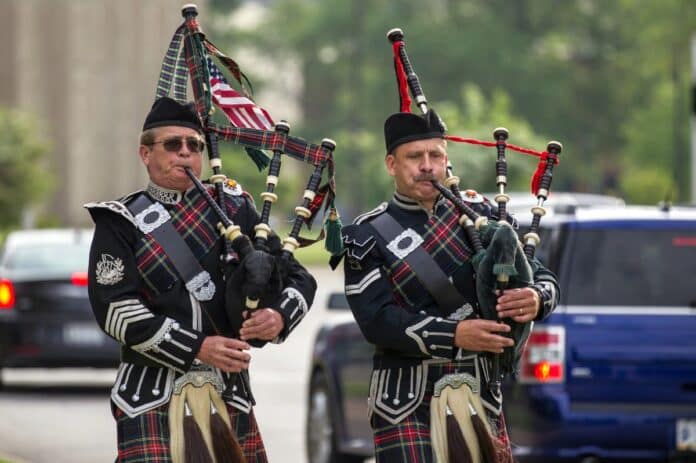
Only a rare few attempt learning to play the bagpipes, a traditional instrument that can produce the music of rollicking dances and the most mournful of grieving farewells.
At the Columbus Fire Department, several firefighters are stepping forward to learn how to play the instrument as the next local generation who will perform locally to remember fallen first responders, veterans and others who are carried home to the somber yet lilting tones of a bagpipe.
You don’t have to be Scottish to learn how to play the bagpipes, but a certain Celtic patience and persistence is required, said Mike Kutsko, Columbus Fire Department Deputy Chief of Administration.
Kutsko is working with several recruits, including Training Officer Ben Spencer and Station 5 firefighter Cory Hampton with weekly lessons at Fire Station 1.
[sc:text-divider text-divider-title=”Story continues below gallery” ]Click here to purchase photos from this gallery
Kutsko himself was a new recruit to the fire service in Columbus, who watched bagpiper Kevin Konetzka, Columbus, perform at a firefighter memorial in the late 1990s, and became intrigued. Then-fire chief Gary Burris remarked "Man, I wish we had a bagpiper."
Because he was new on the firefighter force, in his early 30s and more than slightly gung-ho, Kutsko sheepishly admits he was volunteering for everything, and immediately spoke up.
"Well, I could do that," he said.
Prior to that moment, Kutsko had self-taught himself to play a guitar, describing his ability as being able to make recognizable music, but not great music.
Working with Konetzka, Kutsko learned to play, starting off with a practice chanter, which resembles the recorders many fourth and fifth graders learn music on in school, and what Spencer and Hampton are learning to play on today.
Konetzka, who is helping with the lessons now, said Kutsko was a very good student and very motivated to learn the instrument and music. The two now perform together as members of the Southern Indiana Pipes and Drums, a group of pipers from around southern Indiana.
Before picking up bagpipes, each player must learn the musical notes before taking on the wind needed and the double reeds within the actual instrument, Kutsko said. First are notes, then scales, then eventually actual songs. Practices are short, a half-hour or so at a time, because the concentration and breathing needed during practice is wearing after a full day as a firefighter.
When asked how he’s doing so far, Spencer jokes, "Well, I’m about five months into it."
"He inspired me," Spencer said, pointing to Kutsko. "When I first got hired, I was at Station 1, and I heard him playing outside, it was just echoing around us."
Hampton decided to learn how to play because the bagpipes are so embedded in the cultural history of firefighting, and he wanted that to continue.
Historians trace the tradition of bagpipes in firefighter culture to the Great Potato Famine, which resulted in Irish and Scottish immigrants fleeing to the United States. Here they took the only jobs no one else wanted — firefighters and police officers — and brought the tradition of playing bagpipes for those who died in the line of duty.
"It was somehow OK for a hardened firefighter to cry at the sound of pipes when his dignity would not let him weep for a fallen comrade," wrote Merritt Long in an essay on Firefighting History and Traditions.
Today, the tradition is universal and not just for the Irish or Scottish, Long wrote. "The pipes have come to be a distinguishing feature of a fallen hero’s funeral."
Hampton, who found out he has Scottish ancestry on the ancestry.com website, said it was "the tradition of it, its uniqueness to fire culture," as to why he wanted to learn to play.
But whether Scottish or not, the instrument itself is a challenge.
Bagpipes produce music from enclosed reeds that are supplied with a constant stream of air held in a bag. Although there are hundreds of different types of bagpipes, most consist of the same basic elements: an air supply, a bag, a chanter and a drone. The air that is blown into the instrument must be balanced with the tone of the notes, and regulated to maintain a continuous sound.
"It’s all muscle memory," Kutsko said of the firefighters learning the finger placement for each of the notes. It took Kutsko more than a year before he mastered the finger placements, although he said some musically inclined individuals can move their fingers like lightening over the instrument.
Right now, the bagpipers in training are learning the proper finger positions, the proper sound for each note, and eventually will work up to the scales so famously portrayed in "Do Re Mi" in "The Sound of Music."
Kutsko, who can now play many memorable renditions from memory on the bagpipes, allows that he has no Celtic blood or background in Scotland, but the bagpipes’ sound has long spoken to him.
"I just love the sound of them," he said. "I love playing at funerals or special events. To me, it adds so much to the ceremony — at funerals people come up to me afterwards to thank me, but I don’t do this for a pat on the back. It’s my contribution in paying homage," he said.
Kutsko and Konetzka are familiar performers at the remembrance ceremonies for the fallen police and firefighters, for the 9/11 remembrance ceremony and at the POW/MIA ceremony at the Bartholomew County Veteran’s Memorial at the courthouse. If there is a line-of-duty death, Kutsko said it is important that a bagpiper is there.
The bagpipes have taken Kutsko all around Indiana and given him brushes with some very famous people.
"This thing (holding his bagpipes) has gotten me into more interesting places than I can say," he said.
At one time, Kutsko played for the late J. Irwin Miller, although Kutsko said he wasn’t sure if the legendary Cummins leader enjoyed his performance. "But he was smiling," Kutsko said.
Kutsko performed at 100th Running of the Indianapolis 500 and has marched across Lucas Oil Stadium for the home opener for the Indianapolis Colts, he said.
While most people remember how haunting "Amazing Grace" sounds on a bagpipe, Kutsko has several favorites that he plays at ceremonies or funerals where listeners might not know the name of the song, but cannot forget the beautiful and lilting melodies.
One, "Scots Wha Hae," was memorized while he was learning how to play. "Flowers in the Forest," based on the remembrance of a devastating Scottish battle, is another that he often plays, along with "Scotland the Brave."
At funerals, Kutsko often plays "Going Home," a melancholy yet sweet melody that he times to the removal of the casket from the hearse into the hands of the pall bearers.
Remembering the symbolism of what he’s performing, Kutsko has a flag on his bagpipes, which has significance to the remembrance of fallen firefighters.
The striped black flag has a line of red through the center, originally designed as a remembrance of all who are deployed in military service, he said.
The fire service around the nation has adopted the flag as a recognition of firefighters who have died trying to save lives in their communities.
"It’s my tribute to the fallen," he said.
[sc:pullout-title pullout-title=”Irish or Scottish?” ][sc:pullout-text-begin]
The tradition of bagpipes played at firefighter and police funerals in the United States goes back more than 150 years, according to a history of bagpipes and firefighting by Merritt Long in the publication "Firefighting History and Traditions."
When the Irish and Scottish immigrated to the United States, many became police officers and firefighters and brought their traditions with them. One of those traditions was the bagpipe, often used at Celtic weddings, funerals and dances, according to Long.
The Scottish version of the bagpipes tend to be louder and better suited to outdoor use.
[sc:pullout-text-end][sc:pullout-title pullout-title=”About the Southern Indiana Pipes and Drums” ][sc:pullout-text-begin]
Southern Indiana Pipes and Drums was formed in the mid-1990s through initial organizational efforts by the Columbus Police Department.
Kevin Konetzka, who is retired from Columbus Animal Control, said the idea to organize a local group came about through the local Scottish Festival and interest from the late former Columbus First Lady Barbara Stewart who was very supportive of the group.
Now one of the largest bagpipe bands in the region, the group’s active membership includes about 20 to 30 individuals ranging in age from 7 to 78 and in experience from fresh beginner to competition grade piper.
The group is a regimental (military style) band that includes members from Columbus, Bloomington, North Vernon and Greensburg, according to its website.
Konetzka said the group wears the Scottish black Stewart tartan, in memory of Barbara Stewart.
For more information: southernindianapipes.com.
[sc:pullout-text-end]




